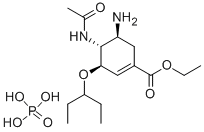ROCK PHOSPHATE
- Empirical Formula: 3Ca3(PO4)2·CaR2
- Molecular Weight: 0
What is ROCK PHOSPHATE?
Agricultural Uses
Rock phosphate is a natural mineral found as a geological
deposit on a large scale in the form of sedimentary rocks
containing various amounts of calcium phosphates. Once
ground, it is used as a phosphatic fertilizer, called
phosphorite or mineral phosphate, or as a primary
source of phosphorus.
Rock phosphate deposits are found in many countries,
such as the USA, Russia, Tunisia, Malaysia, Sri Lanka,
Israel, Jordan, etc. India alone is estimated to have about
140 million tons of rock phosphate deposits, most of
which are however, of low grade and with substantial
impurities unsuitable for the production of phosphate
fertilizers.
A large part of mined rock phosphate is used
to manufacture single superphosphate, triple
superphosphate, tri-calcium phosphate and calcium
metaphosphate. Finely ground rock phosphate can be
applied directly to the soil if it is strongly acidic, as it has
a high humus content. It is, however, not recommended
for neutral or alkaline soils where acid-treated rock
phosphate (like superphosphate) is used. The material
should optimally be in the mesh size of 60 to 100.
Powdered rock phosphate is free-flowing and is easily
amenable to handling and storage. Crops like rubber, tea,
coffee, apples and fruit plantations of oranges are suitable
for direct application of rock phosphate.
The most predominant mineral of phosphate is
francolite which is calcium carbonate-fluorapatite of
formula [Ca5(PO4,CO3)3(F,OH)]. Four kinds of
phosphate rocks are recognized: hard rock phosphate,
sofc rock phosphate, land pebble phosphate and river
pebble phosphate, with the phosphorus content varying
from 2 to 21 %
Most of the phosphorus in the phosphate rock is in an
apatite form. There is, therefore, no water-soluble
phosphorus. The citrate solubility can vary from 5 to 17 %
of the total phosphorus, depending on the chemical nature
of the ruck and the size to which it is ground. The
efficiency of the ground rock phosphate can be increased
by (a) mixing rock phosphate with soluble phosphorus
and fertilizers, (b) mixing rock phosphate with elemental
sulphur or sulphur-producing compounds, and (c) using
phosphate solubilizing micro-organisms
Over 90% of the rock phosphate production, starting
with high-grade rock phosphate without impurities, is
used in acidulating factories to produce superphosphate
and phosphoric acid. Less than 8 % of rock phosphate is
used directly as soil fertilizer and about 2 % as animal and
poultry feed.
Safety information for ROCK PHOSPHATE
New Products
(S)-3-Aminobutanenitrile hydrochloride 4-Methylphenylacetic acid N-Boc-D-alaninol N-BOC-D/L-ALANINOL Tert-butyl bis(2-chloroethyl)carbamate 3-Morpholino-1-(4-nitrophenyl)-5,6-dihydropyridin- 2(1H)-one Furan-2,5-Dicarboxylic Acid Tropic acid 1-Bromo-3,5-Di-Tert-Butylbenzene S-2-CHLORO PROPIONIC ACID ETHYL ISOCYANOACETATE 2-Bromo-1,3-Bis(Dimethylamino)Trimethinium Hexafluorophosphate 4-IODO BENZOIC ACID 3-NITRO-2-METHYL ANILINE 1-(2,4-DICHLOROPHENYL) ETHANAMINE (2-Hydroxyphenyl)acetonitrile 4-Bromopyrazole 2-(Cyanocyclohexyl)acetic acid 4-methoxy-3,5-dinitropyridine 1-(4-(aminomethyl)benzyl)urea hydrochloride 2-aminopropyl benzoate hydrochloride diethyl 2-(2-((tertbutoxycarbonyl)amino) ethyl)malonate tert-butyl 4- (ureidomethyl)benzylcarbamate Ethyl-2-chloro((4-methoxyphenyl)hydrazono)acetateRelated products of tetrahydrofuran
You may like
-
 2033-24-1 98%View Details
2033-24-1 98%View Details
2033-24-1 -
 42831-50-5 5-METHYLISOXAZOLE-4-CARBOXYLIC ACID 98%View Details
42831-50-5 5-METHYLISOXAZOLE-4-CARBOXYLIC ACID 98%View Details
42831-50-5 -
 1975-50-4 98%View Details
1975-50-4 98%View Details
1975-50-4 -
 2-HYDROXY BENZYL ALCOHOL 98%View Details
2-HYDROXY BENZYL ALCOHOL 98%View Details
90-01-7 -
 2-Chloro-1,3-Bis(Dimethylamino)Trimethinium Hexafluorophosphate 221615-75-4 98%View Details
2-Chloro-1,3-Bis(Dimethylamino)Trimethinium Hexafluorophosphate 221615-75-4 98%View Details
221615-75-4 -
 61397-56-6 CIS BROMO BENZOATE 98%View Details
61397-56-6 CIS BROMO BENZOATE 98%View Details
61397-56-6 -
 14714-50-2 (2-Hydroxyphenyl)acetonitrile 98+View Details
14714-50-2 (2-Hydroxyphenyl)acetonitrile 98+View Details
14714-50-2 -
 118753-70-1 98+View Details
118753-70-1 98+View Details
118753-70-1



